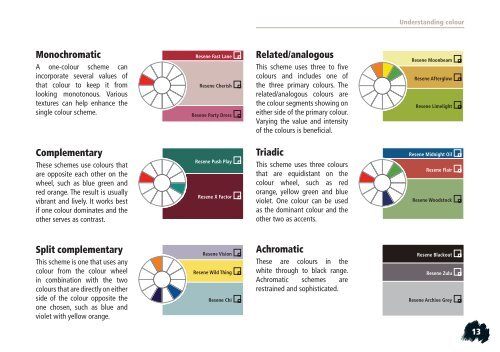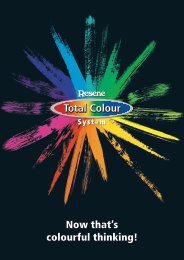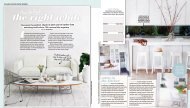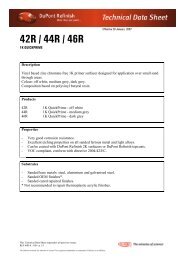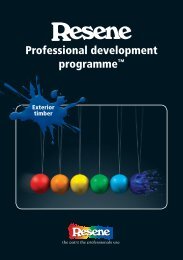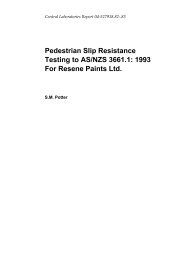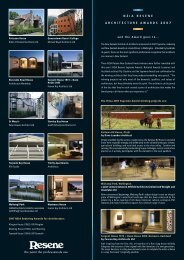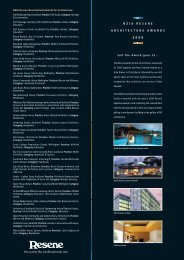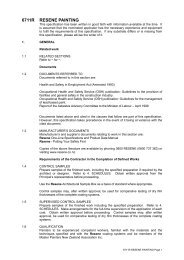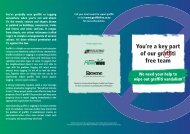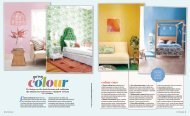Colour Choices - choose colour with creativity and ... - Resene
Colour Choices - choose colour with creativity and ... - Resene
Colour Choices - choose colour with creativity and ... - Resene
Create successful ePaper yourself
Turn your PDF publications into a flip-book with our unique Google optimized e-Paper software.
Monochromatic<br />
A one-<strong>colour</strong> scheme can<br />
incorporate several values of<br />
that <strong>colour</strong> to keep it from<br />
looking monotonous. Various<br />
textures can help enhance the<br />
single <strong>colour</strong> scheme.<br />
Complementary<br />
These schemes use <strong>colour</strong>s that<br />
are opposite each other on the<br />
wheel, such as blue green <strong>and</strong><br />
red orange. The result is usually<br />
vibrant <strong>and</strong> lively. It works best<br />
if one <strong>colour</strong> dominates <strong>and</strong> the<br />
other serves as contrast.<br />
Split complementary<br />
This scheme is one that uses any<br />
<strong>colour</strong> from the <strong>colour</strong> wheel<br />
in combination <strong>with</strong> the two<br />
<strong>colour</strong>s that are directly on either<br />
side of the <strong>colour</strong> opposite the<br />
one chosen, such as blue <strong>and</strong><br />
violet <strong>with</strong> yellow orange.<br />
<strong>Resene</strong> Fast Lane<br />
<strong>Resene</strong> Cherish<br />
<strong>Resene</strong> Party Dress<br />
<strong>Resene</strong> Push Play<br />
<strong>Resene</strong> X Factor<br />
<strong>Resene</strong> Vision<br />
<strong>Resene</strong> Wild Thing<br />
<strong>Resene</strong> Chi<br />
Related/analogous<br />
This scheme uses three to five<br />
<strong>colour</strong>s <strong>and</strong> includes one of<br />
the three primary <strong>colour</strong>s. The<br />
related/analogous <strong>colour</strong>s are<br />
the <strong>colour</strong> segments showing on<br />
either side of the primary <strong>colour</strong>.<br />
Varying the value <strong>and</strong> intensity<br />
of the <strong>colour</strong>s is beneficial.<br />
Triadic<br />
This scheme uses three <strong>colour</strong>s<br />
that are equidistant on the<br />
<strong>colour</strong> wheel, such as red<br />
orange, yellow green <strong>and</strong> blue<br />
violet. One <strong>colour</strong> can be used<br />
as the dominant <strong>colour</strong> <strong>and</strong> the<br />
other two as accents.<br />
Achromatic<br />
These are <strong>colour</strong>s in the<br />
white through to black range.<br />
Achromatic schemes are<br />
restrained <strong>and</strong> sophisticated.<br />
Underst<strong>and</strong>ing <strong>colour</strong><br />
<strong>Resene</strong> Moonbeam<br />
<strong>Resene</strong> Afterglow<br />
<strong>Resene</strong> Limelight<br />
<strong>Resene</strong> Midnight Oil<br />
<strong>Resene</strong> Flair<br />
<strong>Resene</strong> Woodstock<br />
<strong>Resene</strong> Blackout<br />
<strong>Resene</strong> Zulu<br />
<strong>Resene</strong> Archive Grey<br />
13


